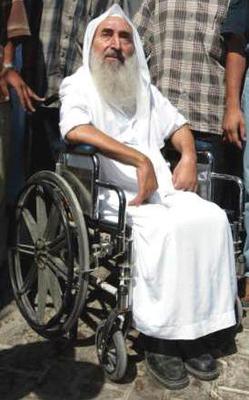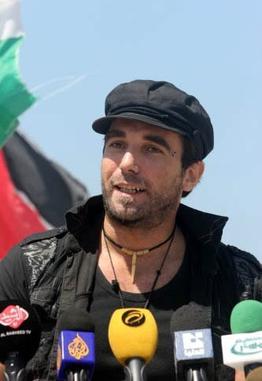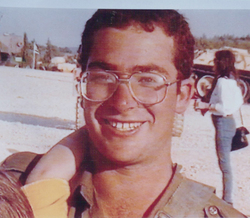
Sheikh Ahmed Ismail Hassan Yassin was a Palestinian politician and imam who founded Hamas, a militant Islamist and Palestinian nationalist organization in the Gaza Strip, in 1987.
Izz El-Deen Sobhi Sheikh Khalil was a senior member of the military wing of the Palestinian Islamist organization Hamas when he was killed by setting an automobile booby trap on September 26, 2004, in the al-Zahera district of southern Damascus, Syria. He was from the Shajaiyeh district of Gaza City. Although no specific groups have taken responsibility for his assassination, it is consistent in style with previous Israeli-sponsored assassinations, and with Israeli pledges to assassinate Hamas leaders.

Mahmoud al-Zahar is a Palestinian politician. He is a co-founder of Hamas and a member of the Hamas leadership in the Gaza Strip. Al-Zahar served as foreign minister in the Hamas-dominated Palestinian Authority Government of March 2006 that was sworn in on 20 March 2006.
The Izz ad-Din al-Qassam Brigades, named after Izz ad-Din al-Qassam, is the military wing of the Palestinian organization Hamas. Currently led by Mohammed Deif, IQB is the largest and best-equipped militant group operating within Gaza today.
Aziz Dweik is a Palestinian politician who was elected the speaker of the Palestinian Legislative Council (PLC) on 18 January 2006.

Gilad Shalit is a former MIA soldier of the Israel Defense Forces (IDF) who, on 25 June 2006, was captured by Palestinian militants in a cross-border raid via tunnels near the Israeli border. Hamas held him captive for over five years until his release on 18 October 2011 as part of a prisoner exchange deal.
The abduction and killing of Nachshon Wachsman was a 1994 incident in which Palestinian Hamas abducted Israeli soldier Nachshon Wachsman from the Bnei Atarot junction in central Israel, and held him hostage for six days. The incident ended in a failed Israeli rescue attempt, during which Wachsman, three of his captors and an Israeli officer were killed.
The History of Hamas is an account of the Palestinian Islamist fundamentalist socio-political organization with an associated paramilitary force, the Izz ad-Din al-Qassam Brigades. Hamas (حماس) Ḥamās is an acronym of حركة المقاومة الاسلامية Ḥarakat al-Muqāwamat al-Islāmiyyah, meaning "Islamic Resistance Movement".
Ahmed al-Jabari, also known as Abu Mohammad, was a senior leader and second-in-command of the military wing of Hamas, the Izz ad-Din al-Qassam Brigades. He was widely credited as the leading figure in the Hamas takeover of the Gaza Strip, and commanded the 2006 Hamas cross-border raid which resulted in the capture of Israeli soldier Gilad Shalit. Under his command, along with chief logistics officer Mahmoud al-Mabhouh, Hamas developed its own military weapons capability significantly by acquiring longer-range guided missiles and rockets.
The Jibril Agreement or "Jibril Deal" was a prisoner exchange deal which took place on 21 May 1985 between the Israeli government, then headed by Shimon Peres, and the Popular Front for the Liberation of Palestine - General Command. As part of the agreement, Israel released 1,150 security prisoners held in Israeli prisons in exchange for three Israeli prisoners captured during the First Lebanon War. This was one of several prisoner exchange agreements carried out between Israel and groups it classified as terrorist organizations around that time.
Events in the year 1992 in Israel.
Events in the year 2010 in the Palestinian territories.

Vittorio Arrigoni was an Italian journalist and activist. He worked with the Palestinian-led International Solidarity Movement (ISM), through which he arrived in the Gaza Strip in 2008. He maintained a website called Guerrilla Radio and also published a book about his experiences in Gaza City during the 2008–2009 Gaza War between Hamas and Israel. In 2011, he was abducted and murdered by a group of Salafi jihadists. The Hamas government, which identified the perpetrators as Palestinian and Jordanian affiliates of al-Qaeda, subsequently initiated a manhunt and arrested the accused suspects during a raid on the Nuseirat refugee camp. Arrigoni was the first foreign national to have been involved in such an incident in the Gaza Strip since the kidnapping of British journalist Alan Johnston in 2007.
The Beersheba bus bombings were two suicide bombings carried out nearly simultaneously aboard commuter buses in Beersheba, Israel, on August 31, 2004. 16 people were killed and more than 100 were injured. Hamas claimed responsibility for the attacks.

The 2006 Gaza cross-border raid was an armed incursion carried out by seven or eight Gazan Palestinian militants on 25 June 2006 who attacked Israel Defense Forces (IDF) positions near the Kerem Shalom Crossing through an attack tunnel. In the attack, two IDF soldiers and two Palestinian militants were killed, four IDF soldiers were wounded, one of whom was Gilad Shalit, who was captured and taken to the Gaza Strip.

The Gilad Shalit prisoner exchange, also known as Wafa al-Ahrar, followed a 2011 agreement between Israel and Hamas to release Israeli soldier Gilad Shalit in exchange for 1,027 prisoners — almost all Palestinians and Arab-Israelis, although there were also a Ukrainian, a Jordanian and a Syrian. Two hundred and eighty of these had been sentenced to life in prison for planning and perpetrating various attacks against Israeli targets.
The killing of Avi Sasportas and Ilan Saadon refers to two Israeli soldiers abducted by Hamas on February 16 and May 3, 1989, and subsequently killed. They were the first victims of the newly founded Palestinian militant organization. Ilan Saadon's body was found in 1996.

On August 5, 1993, Hamas militants abducted and later killed Israeli soldier Yaron Chen.
Ismail Abu Shanab was a Palestinian engineer and one of the founders of Hamas. He was one of its three most senior leaders in Gaza. More specifically, he was the second highest leader of Hamas only after Sheikh Ahmed Yassin. He was also the political leader of Hamas, who was strongly against suicide bombings and in favor of a long-term truce.

The 2014 Gush Etzion kidnapping and murder refers to the abduction and killing of three Israeli teenagers in the West Bank during June 2014. The victims, Eyal Yifrach, Gilad Shaer, and Naftali Fraenkel, were Israeli students aged 16 and 19. On the evening of 12 June 2014, the three teenagers were hitchhiking in the Alon Shvut settlement in Gush Etzion, in the West Bank when they were abducted.







